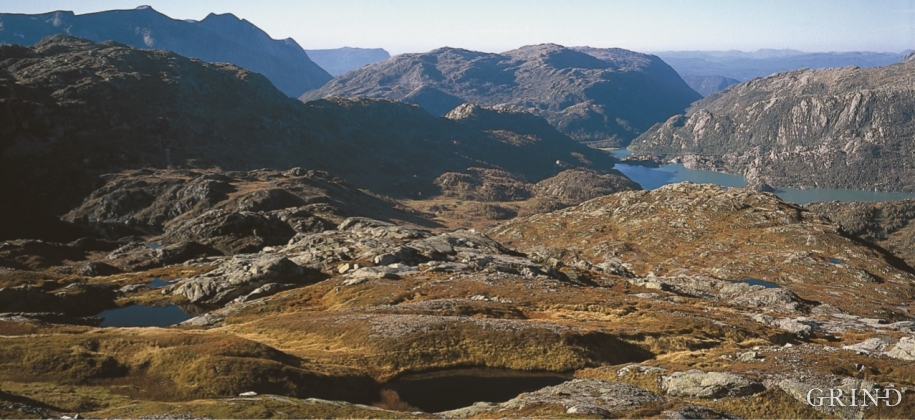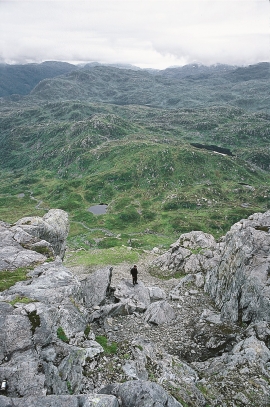Published: 20.07.2015 | Author: Haakon Fossen, Øystein Jansen
From Ingahogg. Ulvanosa back left. (Svein Nord)
SOAPSTONE QUARRY AT 1000 METRES ELEVATION
At nearly 1000 metres over sea level, on the north side of INGAHOGG mountain, the remains of a soapstone quarry have been discovered. It is said, according to the Sagas, that Inga collected the big soapstone that lies in front of the Åkra Church from here.
Soapstone is soft and easy to shape. Therefore it was a sought-after rock type in earlier times. It is a rather unusual rock type, but in association with the gabbro field in Sunnhordland, a lesser deposit is found that originates from the serpentine, which some places has been altered to soapstone.
In the quarry one sees evidence of the removal of pots and pans, but the soapstone from here has very probably also been used as net sinkers loom weights, casting moulds etc. Larger blocks were also carved out, but what one used them for, is unknown. The quarry at Ingahogg has not been investigated more closely. Therefore, we cannot date when it was in operation, but there probably has been quarrying going on here for a long time. In Kvinnherad there is also a soapstone quarry in Åkra and Rosendal. There may be other undiscovered quarries. If you want to hunt for one, it is best to look in association with the gabbro field.
View of the quarry toward the north. The rock knolls at the front of the picture lie inside of the quarry area. Here, one can find scattered traces of the cutting for removing the stone along an inclined shelf in the mountainside. Remember that the soapstone quarry is a protected monument - dont' use a knife or take stone out from the quarry. (Svein Nord)
Gabbro belt at Kvinnherad
In the bedrock from Rosendal to Åkra Fjord there is a several kilometre wide belt of basic rock types. Geologists call this zone the "gabbro belt", but it also contains many other rock types. It is the remnants of Hordaland's continental crust from a half a billion years ago. The rock types are testimony to the oldest chapter in the geological history of Hordaland.
The Precambrian crust was primarily formed of solidified iron- and magnesium-rich magmas from deep below the earth's surface. What these gabbro magmas intruded into, we do not know. Perhaps a whole new crust was formed and the old one torn up and shoved to the side. Later, the granite magmas intruded into the gabbro crust, such that only the remains of the old crust are found today.
- Sigmond, E. M. O. 1975. Geologisk kart over Norge, berggrunnskart Sauda – M 1:250.000. Norges geologiske undersøkelse.






